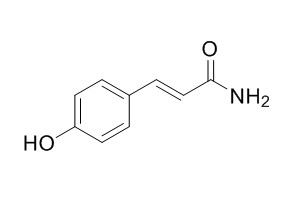4-Hydroxycinnamamide
4-Hydroxycinnamamide has antioxidant activity. 4-Hydroxycinnamamide derivatives are specific inhibitors of tyrosine-specific protein kinases.
Inquire / Order:
manager@chemfaces.com
Technical Inquiries:
service@chemfaces.com
Tel:
+86-27-84237783
Fax:
+86-27-84254680
Address:
1 Building, No. 83, CheCheng Rd., Wuhan Economic and Technological Development Zone, Wuhan, Hubei 430056, PRC
Providing storage is as stated on the product vial and the vial is kept tightly sealed, the product can be stored for up to
24 months(2-8C).
Wherever possible, you should prepare and use solutions on the same day. However, if you need to make up stock solutions in advance, we recommend that you store the solution as aliquots in tightly sealed vials at -20C. Generally, these will be useable for up to two weeks. Before use, and prior to opening the vial we recommend that you allow your product to equilibrate to room temperature for at least 1 hour.
Need more advice on solubility, usage and handling? Please email to: service@chemfaces.com
The packaging of the product may have turned upside down during transportation, resulting in the natural compounds adhering to the neck or cap of the vial. take the vial out of its packaging and gently shake to let the compounds fall to the bottom of the vial. for liquid products, centrifuge at 200-500 RPM to gather the liquid at the bottom of the vial. try to avoid loss or contamination during handling.
Oxid Med Cell Longev2020, 12
Biomed Pharmacother.2020, 128:110318.
J.Food Pharm.Sci.2024, 12(2), 116-124.
Foods.2022, 11(6):882.
Biomolecules.2021, 11(10):1537.
J Appl Pharm Sci.2022, 12(04):044-053
Life (Basel).2023, 13(2):457.
Cell Commun Signal.2024, 22(1):597.
Pharmaceuticals (Basel).2024 Feb 24;17(3):292.
HIV Med.2021, 22(8):690-704.
Related and Featured Products
Cancer Res. 1989 May 1;49(9):2374-8.
Specific inhibitors of tyrosine-specific protein kinases: properties of 4-hydroxycinnamamide derivatives in vitro.[Pubmed:
2706625]
METHODS AND RESULTS:
Inhibition by seven synthetic 4-Hydroxycinnamamide derivatives, ST 271, ST 280, ST 458, ST 494, ST 633, ST 638, and ST 642, of tyrosine-specific protein kinases (tyrosine kinase) of oncogene or proto-oncogene products (p130gag-v-fps, p70gag-actin-v-fgr, pp60v-src, pp60c-src) and epidermal growth factor (EGF) receptor kinase were investigated. ST 638 (alpha-cyano-3-ethoxy-4-hydroxy-5-phenylthiomethylcinnamamide) strongly inhibited more of the tyrosine kinases than any of the other compounds. The susceptibilities of these tyrosine kinases to ST 638 increased in the following order: EGF receptor greater than p70gag-actin-v-fgr greater than pp60c-src greater than p130gag-v-fps, pp60v-src, with 50% inhibitory concentration values of 1.1, 4.2, 18, 70, and 87 microM, respectively. The phosphorylation of the tyrosine residues in particulate fractions from RR1022 cells expressing pp60v-src was inhibited by ST 638 in a dose-dependent way, while it had a negligible effect on the phosphorylations of threonine and serine residues. Kinetic analysis showed that ST 638 competitively inhibited the phosphorylation of an exogenous substrate by the EGF receptor kinase with a Ki of 2.1 microM. ST 638 noncompetitively inhibited autophosphorylation by EGF receptor kinase.
CONCLUSIONS:
These results indicate that ST 638 is a potent and specific inhibitor of tyrosine kinases in vitro, and that its inhibitory activity is caused by competing with the substrate protein for the tyrosine kinase binding site.
Eur J Med Chem. 2015 Jan 7;89:628-37.
Development of 3-hydroxycinnamamide-based HDAC inhibitors with potent in vitro and in vivo anti-tumor activity.[Pubmed:
25462271]
Inhibition of histone deacetylases (HDACs) has diverse effects on cell function, such as causing differentiation, growth arrest and apoptosis in nearly all types of tumor cell lines.
METHODS AND RESULTS:
In our previous work, we have designed and synthesized a novel series of 4-Hydroxycinnamamide-based and 3-hydroxycinnamamide-based HDAC inhibitors (HDACIs), among which, 3-hydroxycinnamamide-based HDACIs 1a-1c exhibited moderate inhibition against HDACs. In this article, we report the development of a more potent class of 3-hydroxycinnamamide-based HDACIs, compound 7o exhibited much higher pan-HDAC inhibitory activity than positive control SAHA. In addition, compound 7h showed excellent in vitro growth inhibitory activity against more than ten cell lines and induced U937 cells apoptosis in micromolar concentration.
CONCLUSIONS:
In vivo assay in U937 xenograft model identified compound 7h as a potent, orally active HDACI.
Bioorg Med Chem Lett. 2002 Sep 16;12(18):2599-602.
Synthesis and evaluation of 4-hydroxyphenylacetic acid amides and 4-hydroxycinnamamides as antioxidants.[Pubmed:
12182869]
4-Hydroxyphenylacetic acid amides and 4-Hydroxycinnamamides were synthesized and their antioxidant and neuroprotective activities were evaluated.
METHODS AND RESULTS:
Among the prepared compounds, 8b, and exhibited potent inhibition of lipid peroxidation in rat brain homogenates, and marked DPPH radical scavenging activities. Furthermore, and exhibited neuroprotective action against the oxidative damage induced by the exposure of primary cultured rat cortical cells to H(2)O(2), xanthine/xanthine oxidase, or Fe(2+)/ascorbic acid.
CONCLUSIONS:
Based on these results, we found that was the most potent antioxidant among the compounds tested.
Biochem Biophys Res Commun. 1987 Aug 31;147(1):322-8.
Specific inhibitors of tyrosine-specific protein kinase, synthetic 4-hydroxycinnamamide derivatives.[Pubmed:
2820397]
METHODS AND RESULTS:
Several newly synthesized 4-Hydroxycinnamamide derivatives such as 3-(3',5'-di-isopropyl-4'-hydroxybenzylidene)-2-oxindol (ST 280), 3-(3',5'-di-methylthiomethyl-4'-hydroxybenzylidene)-2-oxindole (ST 458), alpha-cyano-3-ethoxy-4-hydroxy-5-phenylthiomethylcinnamamide (ST 638) and 3-(3'-ethoxy-4'-hydroxy-5'-phenylthiomethylbenzylidene)-2-pyrol idinone (ST 642) were found to inhibit tyrosine-specific protein kinase activity of the epidermal growth factor (EGF) receptor with IC50 values of 0.44 microM, 0.44 microM, 0.37 microM and 0.85 microM, respectively. None of them showed inhibitory effect on the enzyme activities of serine- and/or threonine-specific protein kinases such as cAMP-dependent protein kinase, Ca2+/phospholipid-dependent protein kinase C, casein kinase I and casein kinase II. In addition, none of them had effect on Na+/K+-ATPase or 5'-nucleotidase.
CONCLUSIONS:
The results suggest that the compound ST 280, ST 458, ST 638 and ST 642 are potent and specific inhibitors of tyrosine-specific protein kinase.
Biochem Biophys Res Commun. 1994 Mar 30;199(3):1447-52.
A possible involvement of tyrosine kinase in TRH-induced prolactin secretion in GH3 cells.[Pubmed:
8147889]
Thyrotropin-releasing hormone (TRH) is a well-known regulatory factor of prolactin (PRL) secretion and synthesis in lactotrophs.
METHODS AND RESULTS:
Recently we have found that TRH stimulates early tyrosine phosphorylation of MAP kinase in GH3 cells.
Then we investigated whether tyrosine phosphorylation in TRH action is involved in TRH-stimulated PRL secretion by GH3 cells, using a 4-Hydroxycinnamamide derivative (ST638), a tyrosine kinase inhibitor. TRH-stimulated tyrosine phosphorylation of MAP kinase and PRL secretion were remarkably inhibited by ST638 treatment.
CONCLUSIONS:
These results suggest that tyrosine phosphorylation of MAP kinase is strongly associated with TRH-stimulated PRL secretion.



